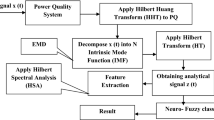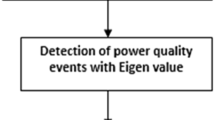Abstract
The proposed technique is different from others in respect that it is based on the concept of local non-linear relation and uses non-linear fuzzy functions to extract the feature-specific data. To extract any change during change in the patterns of power quality (PQ) events, non-linear Gaussian functions have been used which results in the formation of fuzzy lattices. The fuzzy lattices have been expressed in the form of Schrödinger equation to find the kinetic energy (KE) used corresponding to any change occurring in the power quality disturbances. Finally, the KE value embedded in two-dimension space has been used to distinguish PQ events. The method is applied to classify the various PQ events such as transient, sag, swell and harmonics and results are simulated using MATLAB version 7.3. The simulated results validate that the proposed algorithm can efficiently distinguish the PQ events in a single cycle and work perfectly in real time.
Similar content being viewed by others
References
Heydt GT (1994) Electric power quality. Stars in a Circle Publications
Mois′es VR, Szczupak J, Iravani MR, Irene YHG, Dash PK, Alexander VM (2007) Emerging signal processing techniques for power quality applications. EURASIP J Adv Signal Process. Article ID 87425
Gu IYH, Styvaktakis E (2003) Bridge the gap: signal processing for power quality applications. Electr Power Syst Res 66(1): 83–96
Brooks DL, Sabin DD (1996) An assessment of distribution system power quality: the library of distribution system power quality monitoring case studies, vol 3. Tech. Rep. 106294. Electric Power Research Institute, Palo Alto
Abdel-Galil TK, El-Saadany EF, Salama MMA (2003) Power quality event detection using Adaline. Elect Power Syst Res 64(2): 137–144
McDonough RN, Whalen AD (1995) Detection of signals in noise. Academic Press, London
Ribeiro MV, Marques CAG, Duque CA, Cerqueira AS, Pereira JLR (2007) Detection of disturbances in voltage signals for power quality analysis using HOS. EURASIP J Adv Signal Process. Article ID 59786
Anis Ibrahim WR, Morcos MM (2002) Artificial intelligence and advanced mathematical tools for power quality applications: a survey. IEEE Trans Power Deliv 17(2): 668–673
Gerek ÖN, Ece DG (2006) Power-quality event analysis using higher order cumulants and quadratic classifiers. IEEE Trans Power Deliv 21(2): 883–889
Lin CH, Wang CH (2006) Adaptive wavelet networks for power quality detection and discrimination in a power system. IEEE Trans Power Deliv 21(3): 1106–1113
Janik P, Lobos T (2006) Automated classification of power-quality disturbances using SVM and RBF networks. IEEE Trans Power Deliv 21(3): 1663–1669
Gerek ÖN, Ece DG, Barkana A (2006) Covariance analysis of voltage waveform signature for power-quality event classification. IEEE Trans Power Deliv 21(4): 2022–2031
Shukla S, Mishra S, Singh B (2009) Empirical-mode decomposition with hilbert transform for power-quality assessment. IEEE Trans Power Deliv 24(4): 2159–2165
He H, Starzyk JA (2006) A self-organizing learning array system for power quality classification based on wavelet transform. IEEE Trans Power Deliv 21(1): 286–295
Reaz MBI, Choong F, Sulaiman MS, Yasin FM, Kamada M (2007) Expert system for power quality disturbance classifier. IEEE Trans Power Deliv 22(3): 1979–1999
Axelberg PGV, Gu IYH, Bollen MHJ (2007) Support vector machine for classification of voltage disturbances. IEEE Trans Power Deliv 22(3): 1297–1303
Gargoom AM, Ertugrul N, Soong WL (2007) Investigation of effective automatic recognition systems of power-quality events. IEEE Trans Power Deliv 22(4): 2319–2326
Dwivedi UD, Singh SN (2010) Enhanced detection of power-quality events using intra and interscale dependencies of wavelet coefficients. IEEE Trans Power Deliv 25(1): 358–366
Mishra S, Bhende CN, Panigrahi BK (2008) Detection and classification of power quality disturbances using S-transform and probabilistic neural network. IEEE Trans Power Deliv 23(1): 280–287
Zhao F, Yang R (2007) Power-quality disturbance recognition using S-Transform. IEEE Trans Power Deliv 22(2): 944–950
Tenenbaum JB, Silva VD, Langford JC (2000) A global geometric framework for nonlinear dimensionality reduction. Science 290(5500): 2319–2323
Roweis ST, Saul Lawrence K (2000) Nonlinear dimensionality reduction by locally linear embedding. Science 290(5500): 2323–2326
Yeh YR, Huang SY, Lee YJ (2009) Nonlinear dimension reduction with Kernel sliced inverse regression. IEEE Trans Knowl Data Eng 21(11): 1590–1603
IEEE Std. 1159: (1995) IEEE recommended practice for monitoring electric power quality. IEEE Inc., New York, pp, pp 1–59
Edmonds EA (1980) Lattice fuzzy logics. Int J Man Mach Stud 13(4): 455–465
Petridis V, Kaburlasos VG (1999) Learning in the framework of fuzzy lattices. IEEE Trans Fuzzy Syst 7(4): 422–440
Gaing ZL (2004) Wavelet-based neural network for power disturbance recognition and classification. IEEE Trans Power Deliv 19(4): 1560–1568
Author information
Authors and Affiliations
Corresponding author
Rights and permissions
About this article
Cite this article
Kapoor, R., Gupta, R. Classification of power quality disturbances using non-linear dimension reduction. Electr Eng 95, 147–156 (2013). https://doi.org/10.1007/s00202-012-0245-7
Received:
Accepted:
Published:
Issue Date:
DOI: https://doi.org/10.1007/s00202-012-0245-7




